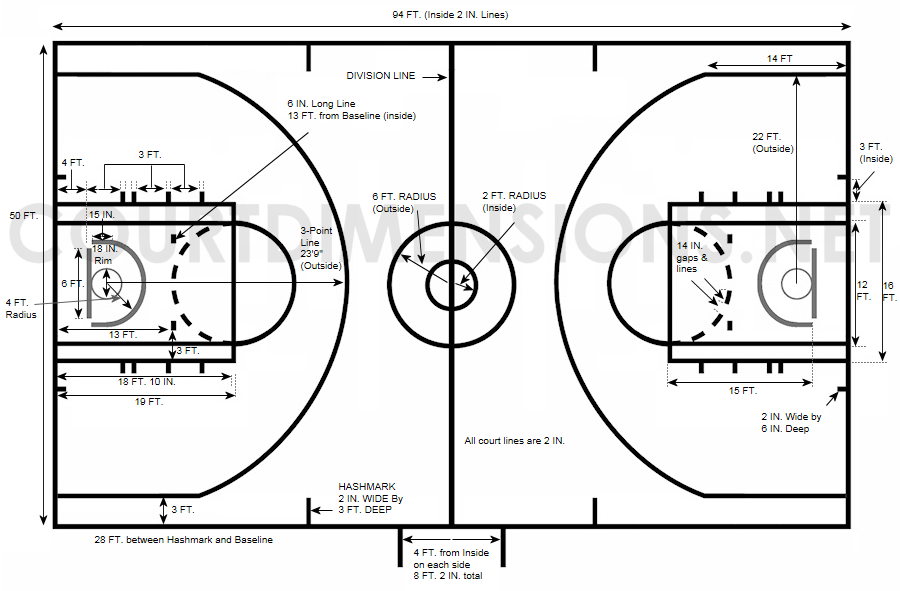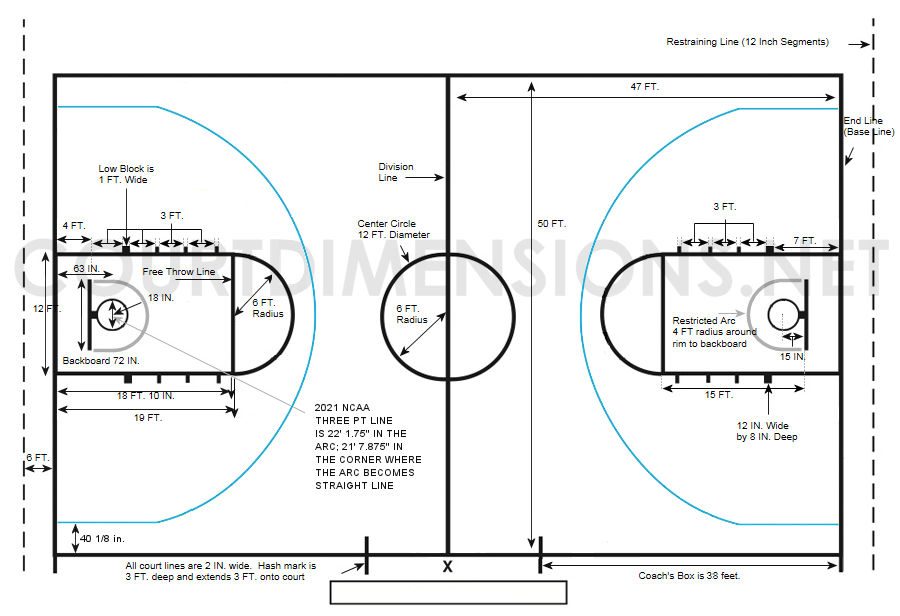Basketball Court Dimensions
Basketball Court Dimensions & Measurements
American Professional Basketball Court
College Basketball Court
High School & Junior High School Basketball Court
The main difference between a college basketball court and a high school basketball court is the three-point line and the overall length of the court. While college courts are 94′ long, high school courts are 84′. Junior high courts are even smaller at 74′ and play with a width of 42′. The other primary difference is high school courts generally do not have a restricted arc under the basket. The three-point line is 19′ 9″ on both high school and junior high basketball courts.
Quick Facts About Basketball Court Measurements
What is the restricted arc?
Typically, it is defined as if a defensive player is inside or touching the arc, they cannot draw a “charge” or an offensive foul.
How far is the free throw line from the basket?
Always 15 feet, regardless of high school, college or the pros.
What’s the size of the basketball hoop?
18 inches across on every level.
How far is a three-point shot?
In high school it is 19′ 9″ from the line to the center of the hoop. In college games, it is 22′ 1.75″ around the arc, but becomes 21′ 7.875″ once is approaches the baseline. In professional leagues, it varies but goes as high as 23′ 9″.
How far is a half-court shot?
Not 47 feet as you might think. If you consider the backboard is 4 feet from the baseline, a half-court shot is 43 feet, unless you’re on a high school court which would then be 38 feet.
The Unexpected Origins of Basketball - A Rainy Day Creation
It seems almost serendipitous that the game of basketball, now a global phenomenon, arose from an instructor simply seeking a vigorous indoor activity to keep rowdy students occupied on a dreary New England winter day.
In December 1891, Canadian physical education teacher James Naismith faced the challenge of designing an energetic game to play inside the gymnasium at the International Young Men’s Christian Association Training School in Springfield, Massachusetts. After analyzing and rejecting other classic sports as too rough or ill-suited for the cramped indoor space, the creative young instructor formulated the13 original rules that would become basketball.
To create a compelling game that discouraged excessive body contact, Naismith turned to an unlikely source of inspiration – two peach baskets he had the custodian install as goals at opposite ends of the gym, suspending them 10 feet high. Using a soccer ball initially, teams of 9 players attempted to toss the ball into the elevated baskets, having to manually retrieve it after each score as the baskets had no holes cut in the bottom.
That first contest on December 21, 1891 must have seemed rather bizarre, even comedic at times, with players struggling to launch an unwieldy ball repeatedly through the raised fruit baskets. Yet Naismith’s strange new game proved engrossing, providing an perfect outlet for youthful energies confined indoors. Word of the unconventional “basket ball” concept quickly spread to other YMCAs, colleges, and athletics clubs.
Within a few years, the bottoms were removed for easier basket evacuations, and small changes were implemented like boundary lines, fouls, and dribbling rules. But the switch from peach baskets to metal horizontal rim-and-backboard units in 1906 marked the game’s biggest evolutionary step. Finally, a ball designed specifically for the new game rather than repurposing a soccer ball emerged around 1914.
Over subsequent decades, basketball rapidly modernized into a fast-paced game of incredible athleticism and spectator appeal as the equipment and rules continued refining. Dribbling skills were hampered until more symmetrical balls were manufactured around 1950. Similarly, the relatively small 3,456 square-foot original court expanded as basketball migrated into larger arenas capable of accommodating more players and fans.
Today’s sleek hardwood courts, bright cushioned back boards, pro-grip balls, and explosive alley-oop jams would have seemed unimaginable to those first raggedy players swatting at peach baskets over a century ago. But at its heart, the electrifying global game of basketball remains true to the essence of Naismith’s simple vision – providing an engaging, indoor athletic outlet.
From its quirky makeshift origins forged out of necessity on a cold, rainy Massachusetts day in 1891, basketball has evolved into one of the most exhilarating and ubiquitous international sports embraced by millions. Not bad for something dreamed up merely as a novel “indoor recreation” to keep restless students happily active.


